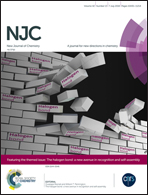Halogen bonding from the bonding perspective with considerations for mechanisms of thyroid hormone activation and inhibition†
Abstract
Halogen bonding interactions are often discussed in terms of an area of positive electrostatic potential on the halogen center along the bond axis called the σ-hole, yet various authors have noted a lack of completeness in this model. The nature of the XB interaction is explored from the perspective of bonding theories beginning from models that explain the electrostatic σ-hole and continuing to orbital-based donor–acceptor descriptions in which the donor lone pair MO mixes with the acceptor R–X and R–X* MOs to form a set of XB MOs related to three-center-four-electron bonding in hypervalent molecules. The strength of the XB interaction for a large series of RX⋯Cl− and RX⋯SeMe2 complexes correlate well with the energy of the acceptor R–X* MO and the contribution of the halide to the R–X and R–X* MOs, factors relevant to favourable overlap with the donor lone pair. An orbital-based focus accounts for the partial covalency of the XB interaction and can be extended to descriptions of enzymatic dehalogenation mechanisms. Applications of this MO perspective to the deiodination of thyroid hormones by the iodothyronine deiodinases and a possibly related mechanism of inhibition are discussed.

- This article is part of the themed collection: The halogen bond: a new avenue in recognition and self-assembly


 Please wait while we load your content...
Please wait while we load your content...